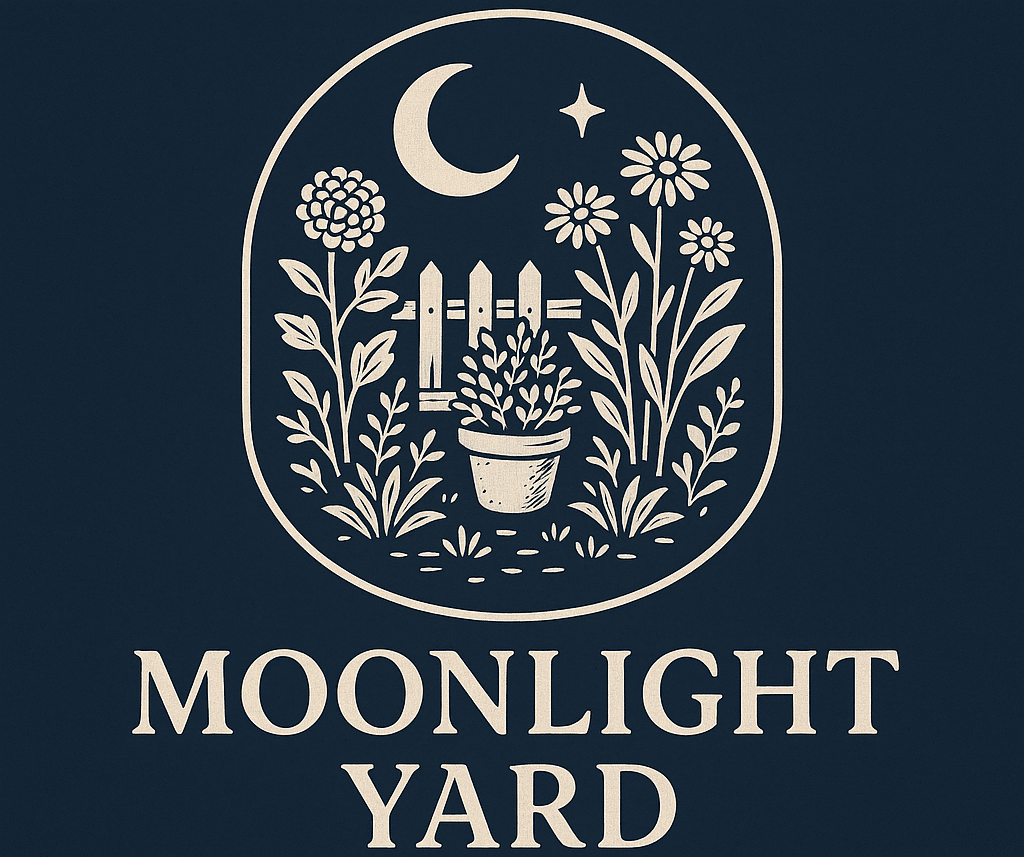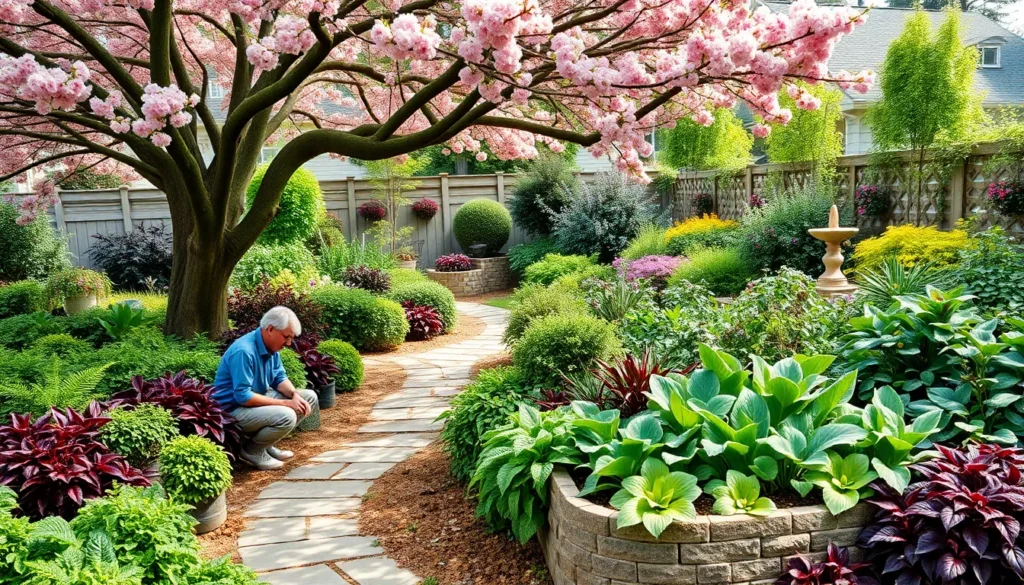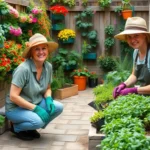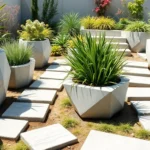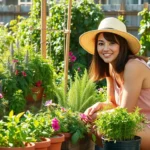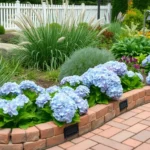We’ve all been there – staring at a north-facing garden space and wondering how to transform it into something spectacular. While these shaded areas might seem challenging at first peek, they’re actually hidden gems waiting to be discovered. North-facing gardens offer unique opportunities that sunny spaces simply can’t match.
Many gardeners mistakenly believe that limited sunlight means limited possibilities. We’re here to shatter that myth completely. These cooler, shadier environments create perfect conditions for stunning foliage plants, delicate flowers, and peaceful retreat spaces that’ll become your favorite outdoor sanctuary.
From lush ferns and vibrant hostas to creative lighting answers and cozy seating areas, we’ll show you how to maximize every square inch of your north-facing space. Your neighbors won’t believe the transformation is possible – but you’re about to prove them wrong.
Embrace Shade-Loving Plants for Your North Facing Garden
Shade loving plants thrive in north facing gardens where direct sunlight remains limited throughout the day. We’ll explore the best options that flourish in these conditions and create stunning visual displays.
Hostas and Heuchera for Colorful Foliage
Hostas transform shaded areas with their dramatic leaf displays and easy care requirements. These perennial favorites offer varieties ranging from miniature 6-inch specimens to giant 4-foot spreads, with colors spanning from deep green to golden yellow and variegated patterns.
Popular hosta varieties include:
- ‘Sum and Substance’ with chartreuse leaves reaching 3 feet wide
- ‘Blue Angel’ featuring blue-green foliage and white flower spikes
- ‘Fire and Ice’ displaying white centers with green borders
Heuchera provides year-round color with foliage in shades of burgundy, coral, lime green, and purple. These compact plants reach 8-12 inches tall and produce delicate flower spikes in late spring, making them perfect for border plantings and container gardens.
Combination plantings work beautifully when we pair large hostas as backdrop plants with colorful heuchera varieties in the foreground. This creates depth and visual interest while maintaining the low maintenance appeal that makes these plants ideal for busy gardeners.
Ferns and Astilbe for Texture and Movement
Ferns bring natural woodland charm to north facing gardens with their feathery fronds and graceful movement. We recommend hardy varieties like Japanese Painted Fern, Lady Fern, and Christmas Fern that tolerate various soil conditions and provide reliable performance year after year.
Astilbe creates dramatic focal points with its fluffy plume flowers in white, pink, red, and purple shades. These perennials bloom from late spring through midsummer, reaching heights of 1-4 feet depending on the variety.
Textural combinations emerge when we plant ostrich ferns behind astilbe borders, creating layers that catch every breeze. The contrast between astilbe’s upright flower spikes and fern fronds adds movement and visual depth to previously static garden spaces.
Maintenance benefits include astilbe’s ability to naturalize over time, forming larger clumps that require division every 3-4 years. Ferns spread gradually through underground rhizomes, filling gaps and creating natural groundcover without aggressive spreading.
Caladiums and Begonias for Seasonal Color
Caladiums deliver tropical flair with heart shaped leaves in combinations of pink, white, green, and red patterns. These tender bulbs perform beautifully in shaded locations where their vibrant colors won’t fade from intense sunlight.
Begonia varieties suited for shade include:
- Wax begonias with glossy leaves and continuous blooms
- Rex begonias featuring metallic and patterned foliage
- Tuberous begonias producing large, rose-like flowers
Seasonal planning involves treating caladiums and tender begonias as annuals in most climates, while hardy begonias like ‘Dragon Wing’ return year after year in protected locations. We plant these colorful options after soil temperatures reach 60°F for best establishment.
Container gardening works exceptionally well for seasonal color plants, allowing us to move displays to optimal locations and bring tender varieties indoors before frost. Mixed containers featuring caladiums, begonias, and trailing plants create stunning focal points for patios and entryways in north facing garden areas.
Create Depth With Layered Planting Schemes
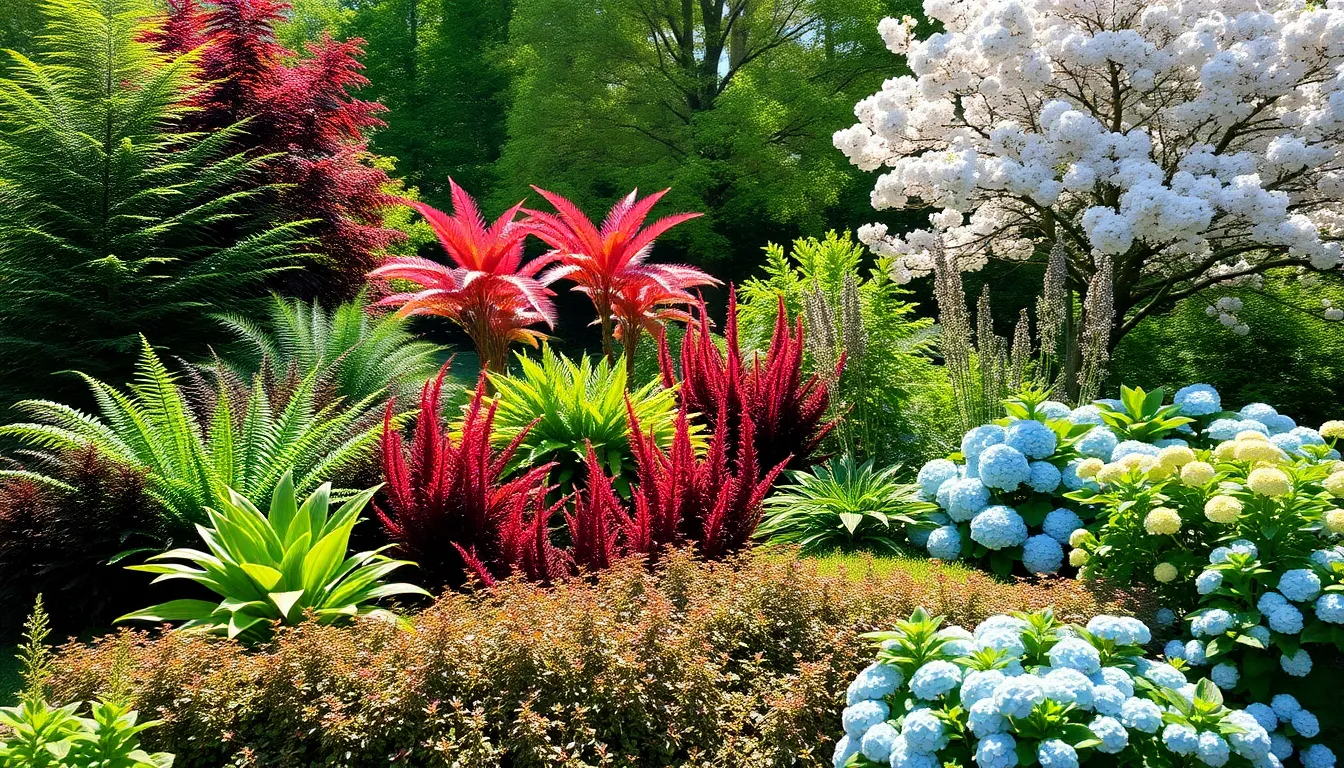
We’ll transform your north facing garden into a dimensional masterpiece by building vertical layers that guide the eye naturally from front to back. Strategic layering creates the illusion of a larger space while maximizing every square foot of your shaded sanctuary.
Tall Background Plants for Structure
Ferns establish magnificent backdrops that thrive in the consistent shade of north facing gardens. Royal ferns and ostrich ferns create towering green walls that provide privacy while adding lush texture throughout the growing season.
Japanese maples deliver year round beauty with their delicate branching structure and seasonal color changes. These graceful trees work perfectly as anchor points, reaching 6 to 20 feet depending on the variety you choose.
Flowering cherry trees bring springtime magic to shaded areas with their stunning blooms appearing before full leaf emergence. We recommend choosing compact varieties like ‘Stella’ or ‘Carmine Jewel’ that won’t overwhelm smaller spaces.
Large shrubs fill vertical gaps between trees and create natural screens for privacy. Rhododendrons and mountain laurel produce spectacular flowers while maintaining evergreen foliage in most climates.
Medium Height Perennials for the Middle Layer
Hostas create dramatic focal points with their bold leaf patterns and varying sizes from 6 inches to 4 feet wide. We love combining blue leafed varieties like ‘Halcyon’ with golden types such as ‘Sum and Substance’ for striking contrast.
Astilbe produces feathery flower plumes in shades of white, pink, red, and purple from late spring through early summer. These reliable perennials reach 12 to 36 inches tall and provide excellent texture when not in bloom.
Hellebores bloom during winter months when most other plants remain dormant, earning their nickname as Christmas roses. These evergreen beauties produce nodding flowers in white, pink, purple, and green from December through March.
Coral bells add colorful foliage in burgundy, lime green, silver, and bronze tones that persist throughout the growing season. Their delicate flower spikes rise 12 to 18 inches above the colorful leaves in early summer.
Ground Cover Plants for the Front Border
Creeping thyme forms fragrant carpets that release pleasant aromas when walked upon, making it perfect for pathway edges. This low growing perennial reaches only 2 to 3 inches tall but spreads 12 to 18 inches wide.
Vinca minor blankets bare soil with glossy evergreen leaves and periwinkle blue flowers in spring. We appreciate its ability to suppress weeds while requiring minimal maintenance once established.
Compact hydrangeas provide colorful borders with their large flower clusters in blue, pink, white, or purple depending on soil pH. Varieties like ‘Little Lime’ and ‘Bobo’ stay under 3 feet tall while delivering full sized blooms.
Wild ginger creates seamless groundcover with heart shaped leaves that form dense mats in deep shade areas. This native plant spreads slowly but surely, making it ideal for large areas that need coverage.
Maximize Light With Strategic Garden Design
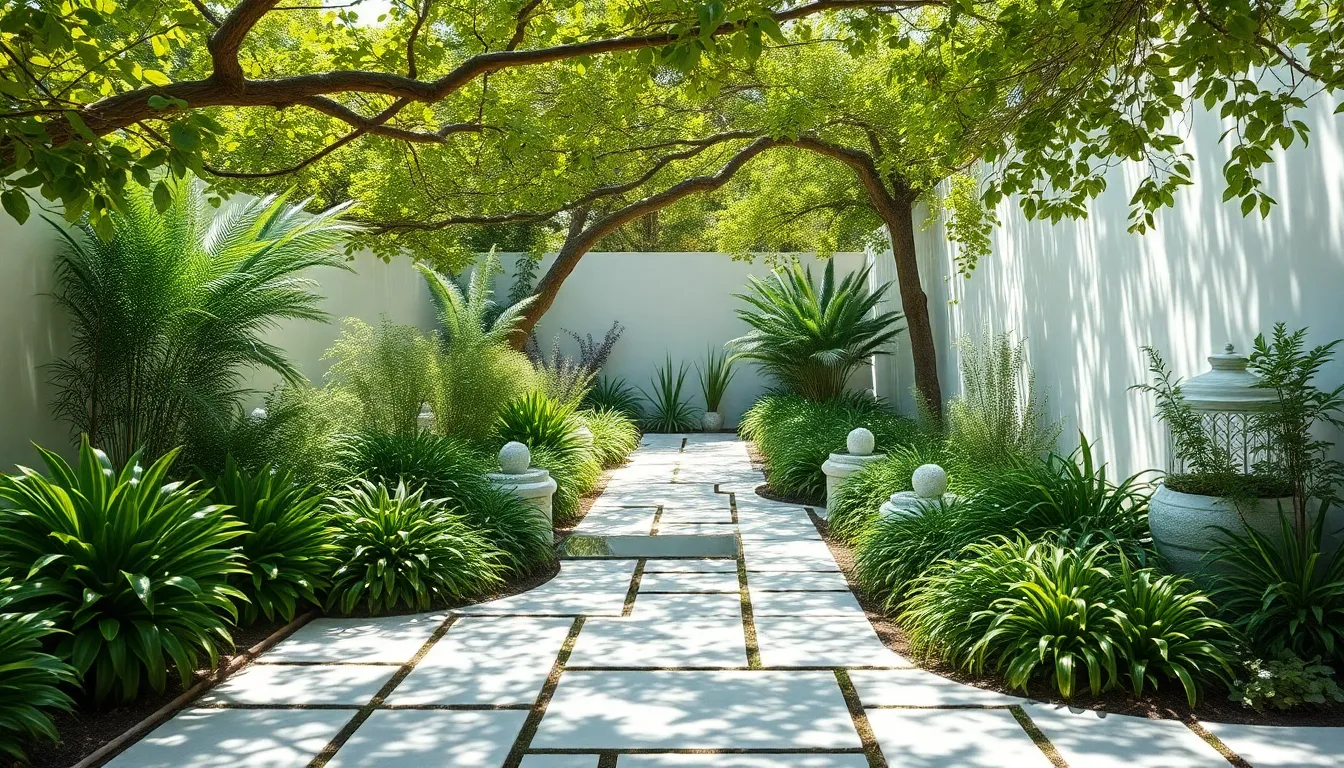
Even with our carefully selected shade plants, we can amplify the limited light in our north-facing gardens through strategic design choices that work with nature’s constraints.
Light-Colored Surfaces to Reflect Available Light
Light-colored pathways and patios become natural light amplifiers in our shaded garden spaces. We can install pale stone pavers, white gravel walkways, or cream-colored concrete surfaces that bounce available sunlight back up to our plants. These reflective surfaces counteract the shadier conditions typical of north-facing gardens by redirecting precious daylight where it’s needed most.
Choosing materials like limestone, light sandstone, or even painted concrete in soft whites and beiges transforms our hardscaping into functional light sources. We’ll notice how these surfaces brighten the entire garden atmosphere while creating clean, elegant pathways that complement our lush plantings.
Mirrors and Reflective Elements for Brightness
Mirrors strategically placed throughout our garden can double the perceived light and create fascinating visual depth. We position weatherproof garden mirrors on fences, walls, or even among tall plants to reflect sunlight into the darkest corners of our space. Garden-exact mirrors resist moisture and temperature changes while maintaining their reflective properties season after season.
Reflective elements like polished metal planters, glass garden spheres, or metallic wind chimes add sparkle and light movement throughout our north-facing garden. We incorporate these elements at different heights to catch and redirect light from multiple angles, creating a brighter environment for both plants and people.
Pruning Overhead Branches to Increase Sunlight
Pruning overhead branches significantly increases sunlight penetration in our established garden spaces. We remove obstructing foliage from trees and large shrubs that block precious morning and afternoon light from reaching our carefully planned plantings below. This selective trimming allows maximum sunlight to filter through during peak daylight hours.
Strategic branch removal creates dappled light patterns that many shade plants actually prefer over harsh direct sunlight. We focus on eliminating dead or crossing branches first, then carefully thin dense canopies to create natural light wells that illuminate exact garden areas while maintaining the sheltered environment our shade plants require.
Install Hardscape Features That Complement Shade Gardens
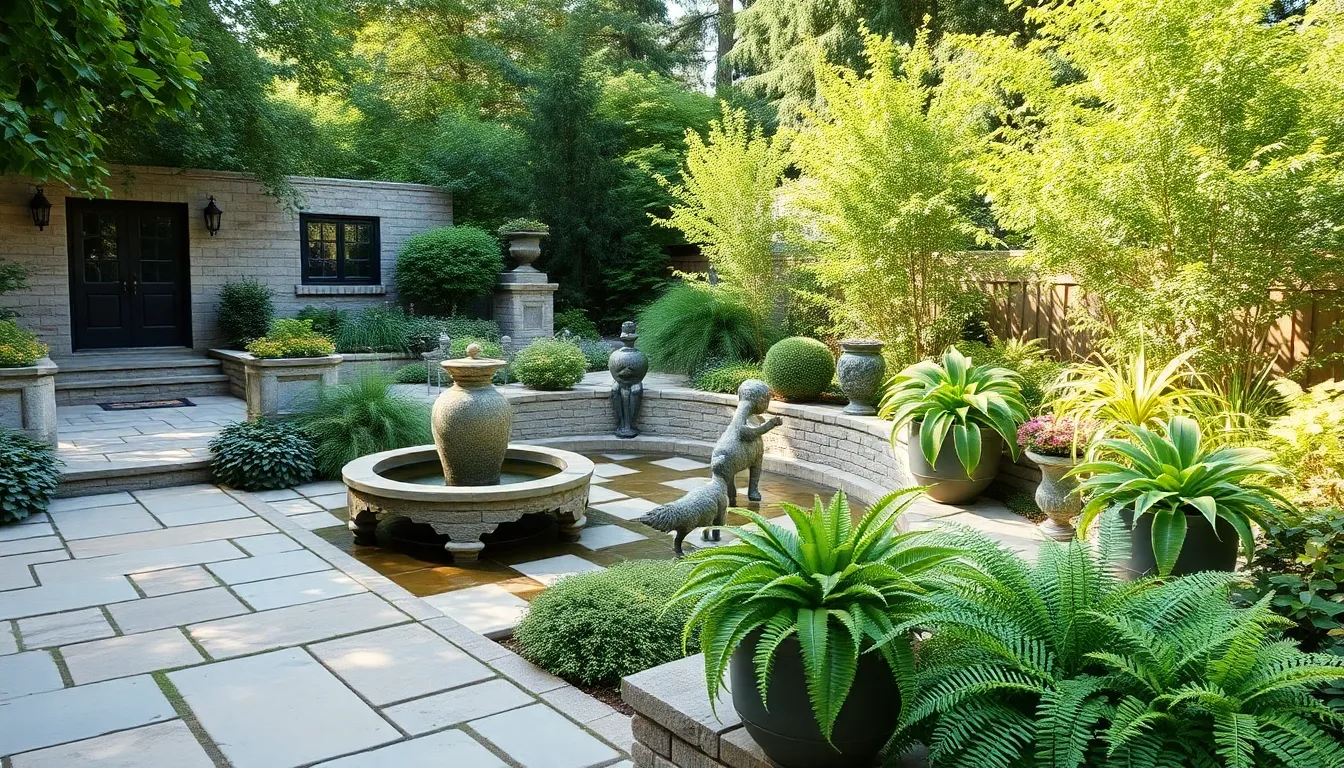
Hardscape elements provide structure and year-round interest in north-facing gardens where plant options might be limited.
Natural Stone Pathways and Patios
Stone pathways create functional walkways while maximizing light reflection in shaded areas. We recommend choosing lighter-colored materials like cream limestone, white marble chips, or pale sandstone to brighten dark corners naturally. These surfaces bounce available sunlight back into the garden space, creating a more luminous atmosphere throughout the day.
Patio installations using light-toned flagstone or concrete transform shaded ground into usable outdoor living spaces. We’ve found that installing these features strategically near the house or under tree canopies provides comfortable seating areas that feel intentionally designed rather than forgotten. The reflective properties of pale stone materials help counteract the natural dimness that north-facing gardens often experience.
Gravel pathways offer another cost-effective option for adding texture and improving drainage in shade gardens. We suggest using white or light gray gravel that complements the overall design while providing practical benefits like preventing muddy walkways during rainy seasons.
Water Features for Sound and Movement
Water features introduce ever-changing elements that engage multiple senses in quiet shade gardens. We recommend installing small fountains or bubbling water bowls that create gentle sounds without overwhelming the peaceful atmosphere these spaces naturally provide. The movement and reflection from water surfaces add visual interest where flowering plants might be scarce.
Pond installations work exceptionally well in north-facing locations since they don’t require direct sunlight to function properly. We’ve observed that still water reflects light beautifully while providing habitat for shade-tolerant aquatic plants like water lilies and lotus varieties that thrive in partial shade conditions.
Wall-mounted water features maximize vertical space while adding ambient sound to enclosed garden areas. We often suggest these installations for narrow side yards or courtyard settings where ground space is limited but the calming effect of flowing water is desired.
Garden Sculptures and Decorative Elements
Sculptural pieces serve as focal points that draw attention away from areas where plants struggle to establish. We position larger sculptures strategically to create visual anchors in both the shadiest corners and spots that receive filtered sunlight throughout the day. These elements provide year-round structure when seasonal plants die back.
Decorative planters and urns allow us to introduce height variations while accommodating movable plant displays. We use these containers to showcase shade-loving specimens like hostas and ferns, then relocate them seasonally to optimize growing conditions as light patterns shift.
Garden mirrors and reflective art pieces amplify available light while creating illusions of expanded space. We install weatherproof mirrors on fences or walls to bounce light deeper into shaded areas, making north-facing gardens feel more open and brighter than their natural conditions would suggest.
Design Seasonal Interest Throughout the Year
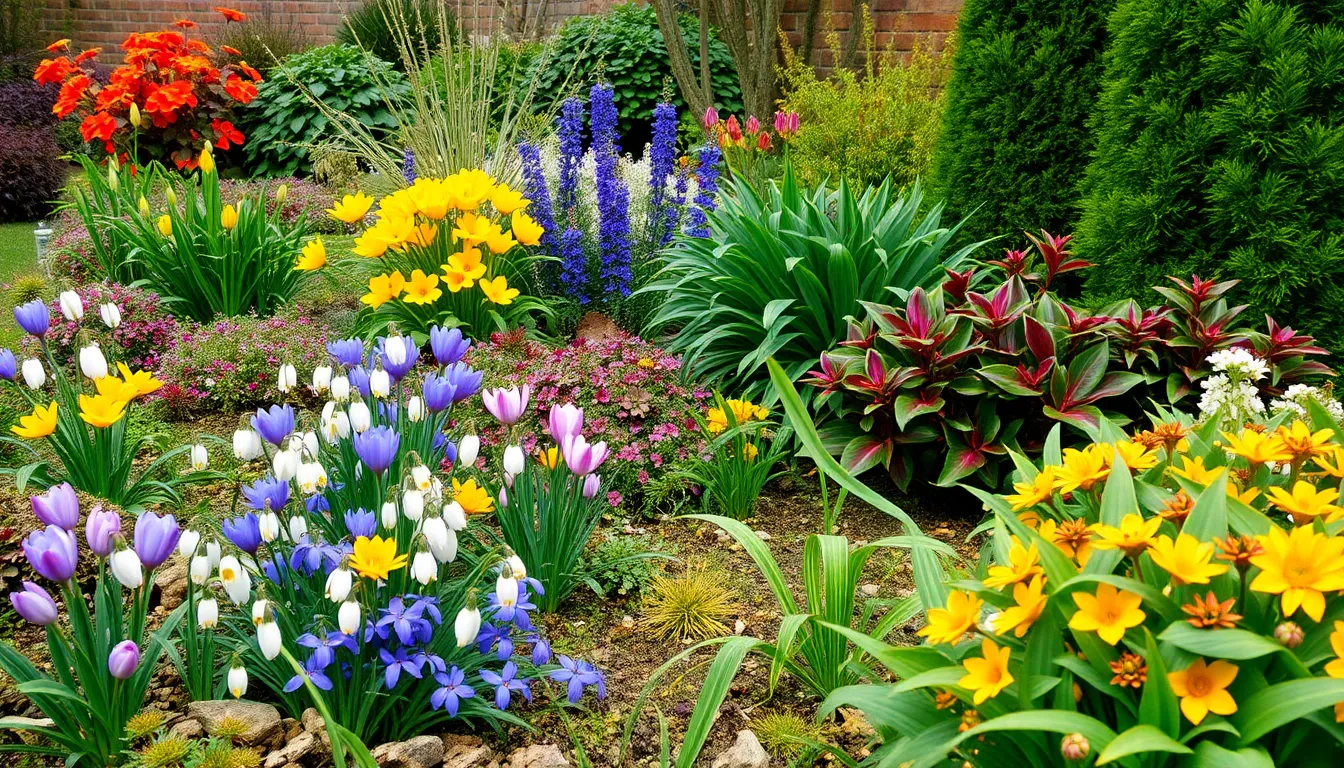
Creating a garden that captivates through every season requires strategic plant selection and thoughtful timing. We’ll show you how to maintain visual appeal from the first spring blooms through winter’s quiet beauty.
Spring Bulbs for Early Color
Snowdrops emerge as the first harbingers of spring in north facing gardens, pushing through the last traces of snow to create delicate white carpets. These early bloomers thrive in the cool, partially shaded conditions that characterize north facing spaces throughout the season.
Crocuses follow closely behind snowdrops, offering purple, white, and yellow flowers that brighten the garden when most plants remain dormant. We recommend planting these bulbs in clusters of 15-20 for maximum visual impact in your shaded beds.
Daffodils provide the most dramatic spring display with their cheerful yellow and white blooms that naturalize beautifully over time. Position them in both garden beds and containers to create flexible color arrangements that you can move as needed.
Container planting offers the greatest flexibility for spring bulbs in north facing gardens. We suggest using large pots that you can relocate to catch morning light or arrange near seating areas for close up enjoyment.
Summer Flowering Shade Plants
Hostas create the backbone of summer shade gardens with their dramatic foliage displays and fragrant white or purple flower spikes. These low maintenance perennials offer leaves in shades ranging from deep green to chartreuse, with some varieties featuring striking variegation patterns.
Impatiens deliver continuous color throughout the summer months in containers and border plantings. We prefer the New Guinea varieties for their larger flowers and improved heat tolerance in partially shaded locations.
Foxgloves add vertical drama with their towering spikes of tubular flowers in pink, purple, white, and yellow. These shade tolerant biennials reach heights of 3-6 feet, creating perfect backdrop plants for shorter perennials.
Coral bells contribute year round foliage interest alongside delicate flower stalks that attract hummingbirds during summer months. Modern heuchera varieties offer leaves in burgundy, lime green, peach, and silver combinations.
Climbing plants maximize vertical space on fences and walls throughout north facing gardens. Star jasmine produces fragrant white flowers while ivy provides evergreen coverage that creates layered visual interest.
Leafy vegetables thrive in these cooler conditions, with lettuce, kale, and arugula producing tender leaves throughout the growing season. We recommend succession planting every 2-3 weeks for continuous harvests.
Fall Foliage and Winter Structure Plants
Japanese maples provide spectacular fall color that rivals any sunny garden display. These graceful trees offer leaves that transform from green to brilliant orange, red, and yellow before dropping to reveal elegant branch structures.
Ferns maintain their appeal as temperatures cool, with many varieties developing golden bronze tones that complement autumn’s palette. Royal ferns and Christmas ferns offer the most reliable winter interest in cold climates.
Evergreen shrubs create essential winter structure when deciduous plants lose their leaves. Wintergreen shrubs provide both foliage and bright red berries that persist through the coldest months.
Ornamental grasses add movement and texture during fall and winter seasons. We recommend fountain grass and sedge varieties that develop attractive seed heads and maintain their form through winter weather.
Hellebores bloom during the darkest winter months, producing flowers in white, pink, purple, and green when little else shows color. These evergreen perennials thrive in the deep shade conditions common in north facing gardens during winter.
Plants with textured bark become focal points once their leaves drop. Paper birch, coral bark maple, and stewartia offer visual interest through their distinctive trunk and branch patterns that catch winter light.
Build Raised Beds and Container Gardens
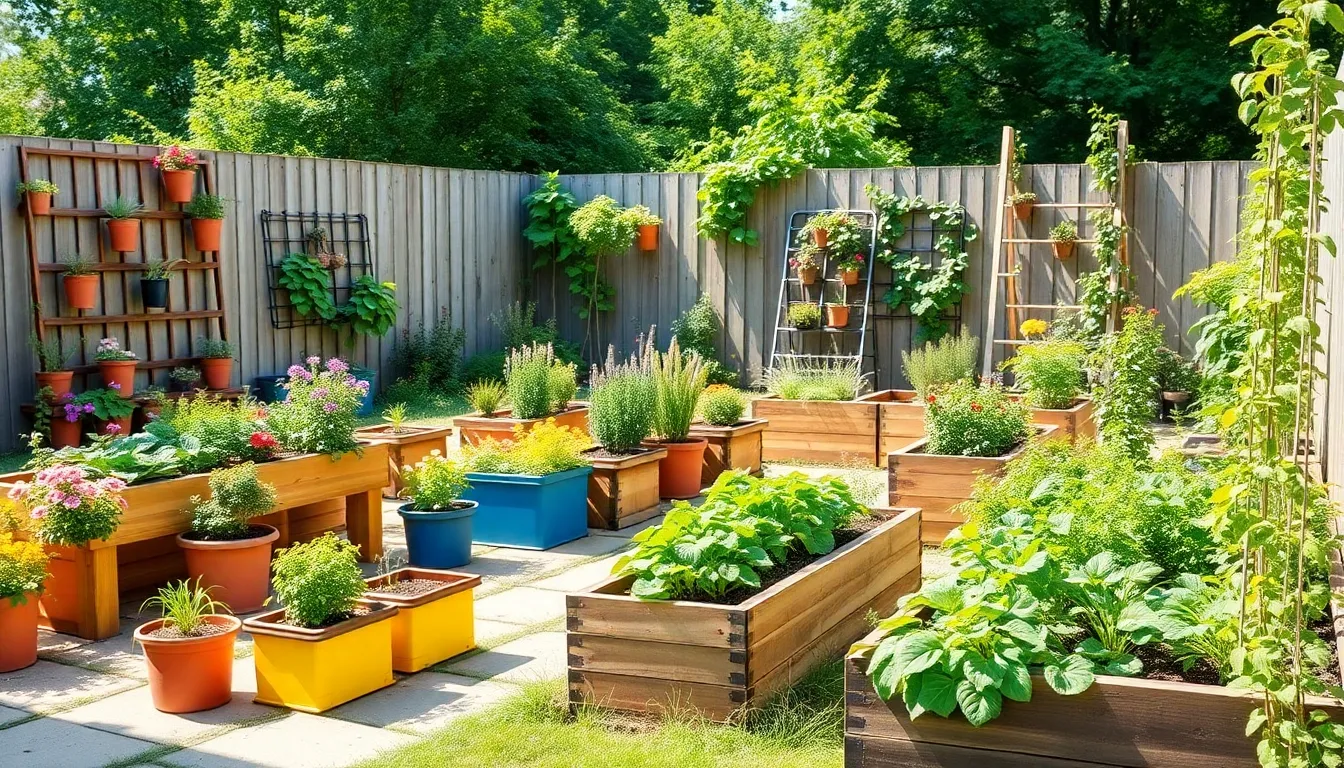
Raised beds and containers transform north facing gardens by creating optimal growing conditions where traditional planting methods fall short. We’ll show you how these elevated answers maximize drainage, provide flexibility, and optimize vertical space in your shaded garden.
Elevated Planters for Better Drainage
Raised beds improve drainage and soil quality dramatically in north facing gardens. Poor drainage becomes a common issue in shaded areas where soil stays moist longer, but elevated planters solve this problem by lifting your plants above problem soil conditions.
Soil aeration increases significantly with raised bed construction. We recommend building beds 8 to 12 inches high to ensure proper drainage while maintaining accessibility for maintenance tasks. Better root growth occurs naturally when plants aren’t sitting in waterlogged soil.
Maintenance becomes easier with raised garden beds positioned at comfortable heights. You’ll spend less time bending over for weeding, watering, and harvesting activities. Premium soil mixes can be added directly to raised beds, giving you complete control over growing conditions regardless of your existing soil quality.
Portable Containers for Flexibility
Movable pots allow you to relocate plants seasonally to maximize available sunlight. Container gardening provides incredible flexibility for north facing spaces where light patterns change throughout the year. We suggest investing in wheeled plant caddies or lightweight containers that you can easily reposition.
Sun loving plants thrive when you can move them to brighter spots during peak growing seasons. Morning sun areas might shift to afternoon locations as seasons change, and portable containers let you follow these patterns. Tomatoes, peppers, and herbs benefit tremendously from this mobility strategy.
Seasonal adjustments become simple with container gardening approaches. Winter protection becomes easier when you can move tender plants to sheltered locations or even indoors. Summer heat stress reduces when you can relocate containers to cooler, shadier spots during extreme weather.
Vertical Gardening Answers for Small Spaces
Vertical gardening maximizes space by utilizing walls, fences, and trellises effectively. North facing gardens often have limited square footage, but vertical growing expands your planting area significantly. Wall mounted planters, hanging baskets, and climbing plant supports create multiple growing levels.
Visual interest increases dramatically with multi level planting arrangements. Trellises support climbing plants like clematis and climbing hydrangeas that thrive in partial shade conditions. Fence mounted planters hold collections of shade loving plants at eye level for maximum impact.
Light optimization improves when you use vertical structures strategically. Plants positioned at different heights capture varying amounts of available light throughout the day. Shadier areas near the ground can accommodate low light plants while elevated positions catch more filtered sunlight.
Incorporate Edible Plants That Thrive in Shade
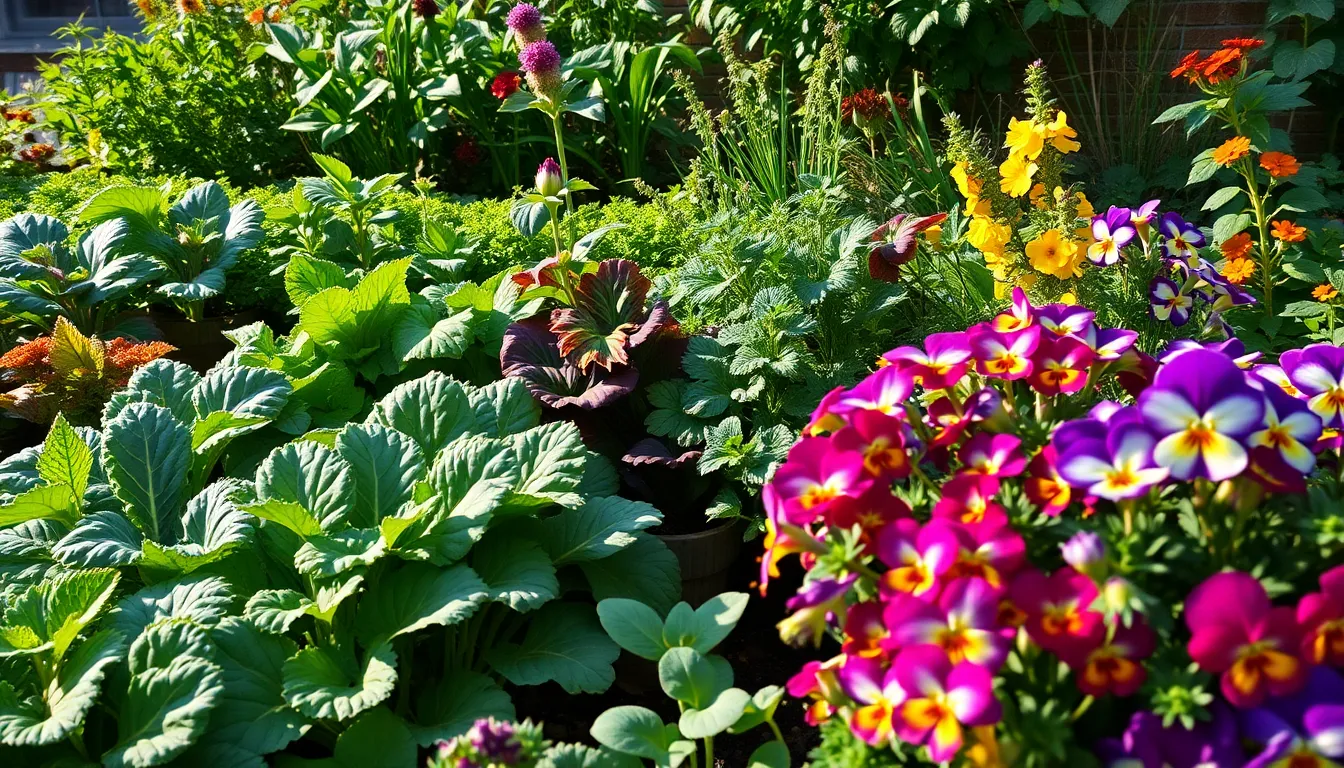
North facing gardens offer perfect conditions for cultivating a productive edible industry. We can transform these shaded spaces into thriving food gardens that provide fresh ingredients year round.
Leafy Greens and Herbs for Cooking
Leafy greens flourish in the cooler conditions of north facing gardens. Kale produces tender leaves with enhanced flavor when grown in partial shade, requiring just 3 to 4 hours of sunlight daily. Spinach thrives in these conditions and actually bolts less frequently than when exposed to intense sun. Lettuce varieties like butterhead and romaine develop crisp textures and mild flavors in shaded locations.
Cooking herbs adapt beautifully to partial shade environments. Mint spreads vigorously in moist, shaded soil and provides fresh leaves for teas and culinary uses. Parsley develops lush foliage in north facing beds, producing abundant harvests throughout the growing season. Chives grow reliably in shade and offer both edible leaves and purple flowers for garnishing dishes.
Shade-Tolerant Vegetables and Fruits
Cool season vegetables perform exceptionally well in shaded garden conditions. Broccoli develops larger heads when protected from intense afternoon sun, producing harvests that extend well into summer months. Cauliflower benefits from partial shade protection, preventing premature bolting and maintaining white, compact heads. Brussels sprouts actually prefer cooler conditions and produce sweeter sprouts when grown in north facing locations.
Fruit options expand our edible shade garden possibilities significantly. Currants produce abundant clusters of tart berries in partial shade conditions, requiring minimal maintenance once established. Gooseberries tolerate shade better than most fruit plants and yield sweet berries perfect for jams and desserts.
Edible Flowers for Garden Beauty
Edible flowers combine ornamental appeal with culinary functionality in shaded gardens. Nasturtiums produce vibrant orange and yellow blooms while their peppery leaves add spice to salads and sandwiches. Both flowers and foliage remain tender and flavorful when grown in partial shade conditions.
Pansies create colorful displays throughout cool seasons while providing delicate petals for cake decorating and salad garnishes. These flowers maintain their sweet flavor and velvety texture when cultivated in north facing garden beds. Violets naturalize easily in shaded areas, producing small purple blooms that taste mildly sweet and work wonderfully in desserts and beverages.
Add Lighting to Extend Garden Enjoyment
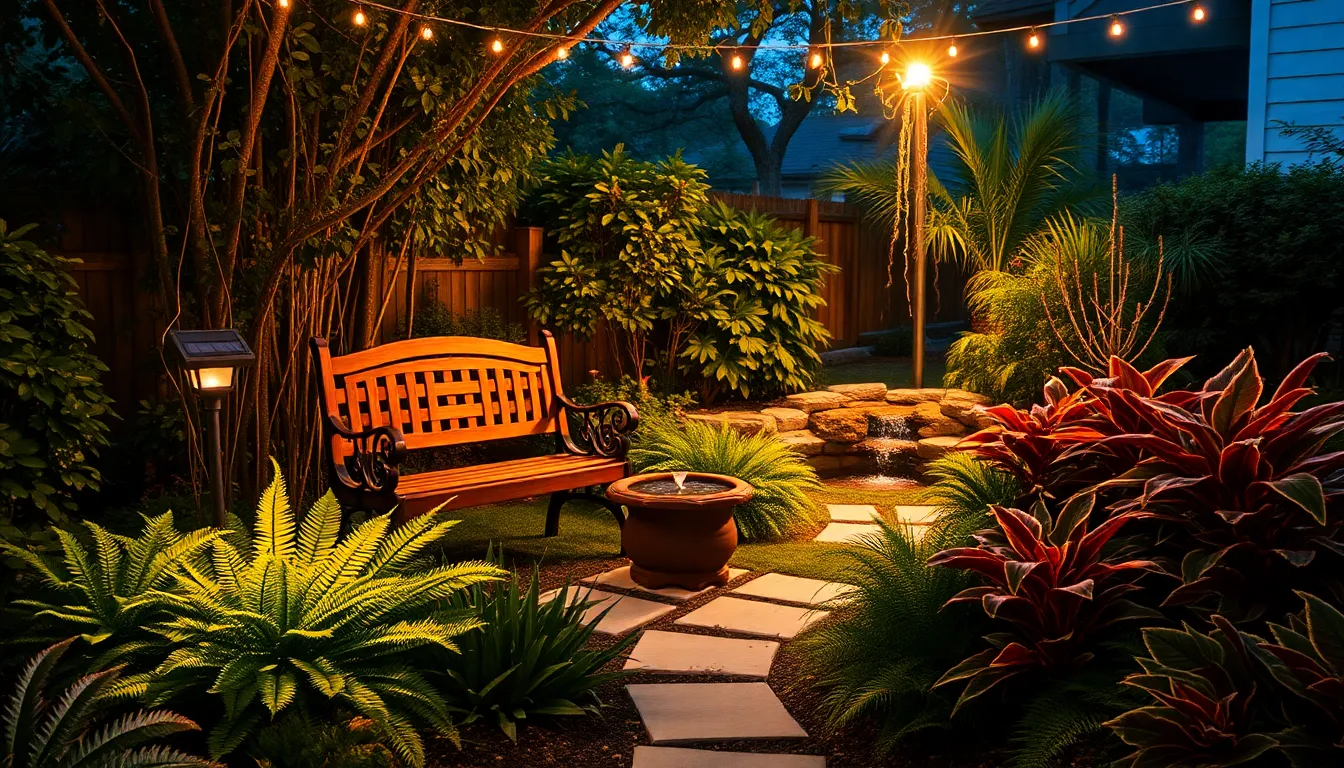
We’ll transform your north-facing garden into a magical evening retreat that extends its usability well beyond daylight hours. Strategic lighting placement makes these shaded spaces accessible and inviting when natural light fades.
Solar Pathway Lights for Safety
Solar pathway lights provide essential safety features while illuminating garden routes throughout darker hours. These energy-efficient fixtures guide visitors along winding stone pathways and gravel walkways without requiring electrical connections or ongoing energy costs.
Positioning solar lights every 6 to 8 feet along main garden paths creates consistent illumination for safe navigation. We recommend installing them near raised bed edges and container garden areas where stepping surfaces change elevation.
Solar technology charges during daylight hours even in partially shaded conditions making them perfect for north-facing gardens. Modern LED solar lights produce bright white or warm yellow light for 8 to 12 hours after a full day’s charge.
String Lights for Ambiance
String lights create cozy atmospheric lighting that transforms evening garden experiences into warm social spaces. These versatile fixtures wrap around fence posts, weave through trellis structures, or drape across seating areas to establish intimate gathering spots.
LED string lights consume minimal energy while producing sufficient illumination for reading plant labels or enjoying dinner outdoors. We suggest installing dimmer compatible versions to adjust brightness levels according to seasonal needs and personal preferences.
Weather resistant string lights withstand seasonal moisture common in shaded garden environments. Warm white bulbs complement the natural green tones of shade loving plants like hostas, ferns, and hellebores without overwhelming their subtle beauty.
Spotlights to Highlight Garden Features
Spotlights create dramatic focal points by highlighting exact garden elements such as water features, sculptures, or specimen plants during nighttime hours. These directional fixtures draw attention to Japanese maples, ornamental grasses, and other architectural plants that maintain winter interest.
Installing adjustable spotlights allows seasonal repositioning to feature spring bulbs, summer flowering plants, or fall foliage displays throughout the year. We recommend using warm LED bulbs rated for outdoor use to prevent harsh lighting that competes with natural garden aesthetics.
Garden mirrors and reflective surfaces amplify spotlight effects while creating illusions of expanded space in compact north-facing areas. Strategic placement near water features doubles their visual impact through reflection while adding movement and sparkle to evening garden scenes.
Choose the Right Mulch and Soil Amendments
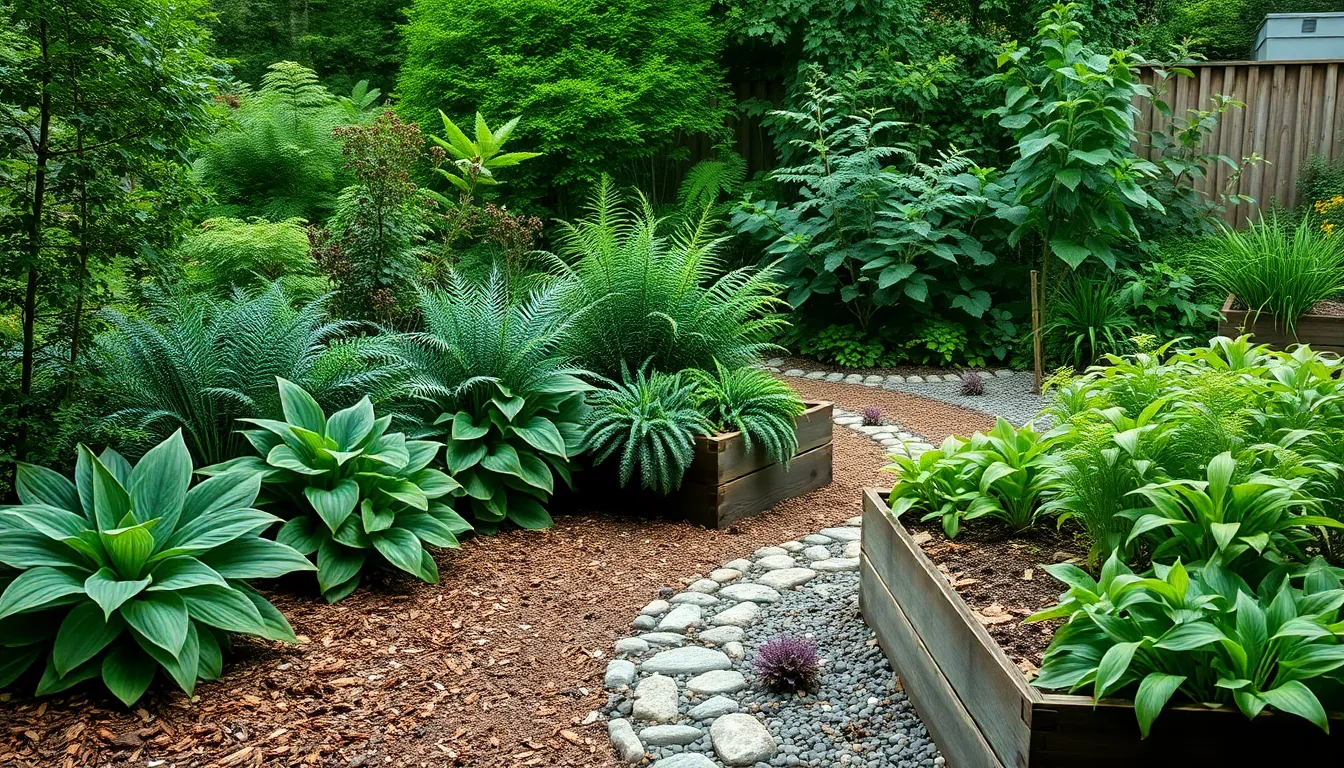
Building on the foundation we’ve established with plant selection and garden design, we need to focus on creating optimal growing conditions through proper mulch and soil management. These amendments become even more critical in north-facing gardens where moisture retention and soil health directly impact plant success.
Organic Mulches for Moisture Retention
Wood chips provide exceptional moisture retention while slowly decomposing to enrich your north-facing garden’s soil over time. We recommend applying a 2-3 inch layer around your shade-loving plants like hostas and ferns to maintain consistent soil moisture levels. Bark mulch offers similar benefits with added aesthetic appeal, creating clean lines around your planted borders while suppressing weeds that compete with your carefully selected shade plants.
Compost serves dual purposes as both mulch and soil amendment, delivering nutrients directly to your plants’ root systems. Shredded leaves collected from autumn cleanup work particularly well in north-facing gardens, breaking down gradually to improve soil structure while protecting plant roots from temperature fluctuations. Straw mulch benefits vegetable areas where you’re growing shade-tolerant greens like kale and spinach, providing excellent insulation during cooler months.
Coffee grounds mixed with other organic materials create nitrogen-rich mulch that acid-loving plants like rhododendrons and azaleas particularly appreciate. We suggest combining coffee grounds with shredded bark or leaves to prevent matting and ensure proper air circulation around plant stems.
Soil Improvements for Better Plant Health
Adding compost annually transforms heavy clay or sandy soils into rich, well-draining growing medium that supports the diverse plant palette we’ve discussed for north-facing gardens. We recommend incorporating 2-4 inches of quality compost into existing soil each spring, working it gently around established perennials and shrubs without disturbing root systems.
Worm castings provide slow-release nutrition that particularly benefits container plants and raised bed installations in your shaded garden areas. Aged manure enriches soil structure while supporting the vigorous growth needed for plants competing for limited sunlight in north-facing conditions. Leaf mold created from decomposed autumn leaves improves soil texture and water retention, making it ideal for areas under trees where natural leaf drop occurs.
Bone meal supports root development in newly planted specimens, particularly beneficial for establishing the Japanese maples and flowering cherries we’ve recommended for background structure. Fish emulsion applied monthly during growing season provides gentle, organic nutrition that won’t burn sensitive shade plants like begonias and caladiums.
Drainage Answers for Wet Areas
Perlite mixed into heavy soils improves drainage while maintaining the moisture retention essential for shade garden success. We suggest adding perlite to planting holes when installing new shrubs or perennials, particularly in areas where water tends to collect after rainfall. Coarse sand incorporated into clay-heavy soil creates better drainage without compromising the water-holding capacity your shade plants require.
Raised beds offer immediate drainage improvement for areas where standing water prevents successful plant establishment. Building beds 8-12 inches high with quality soil mix eliminates drainage issues while providing better growing conditions for the layered planting schemes we’ve outlined. French drains installed in problem areas redirect excess water away from plant root zones while preserving soil moisture during dry periods.
Gravel amendments at planting depth prevent root rot in moisture-loving plants like astilbe while ensuring adequate drainage during heavy rains. We recommend creating drainage channels filled with river rock to direct water flow away from seating areas and toward plants that benefit from additional moisture, like the ferns and hostas featured in your garden design.
Plan for Year-Round Garden Maintenance
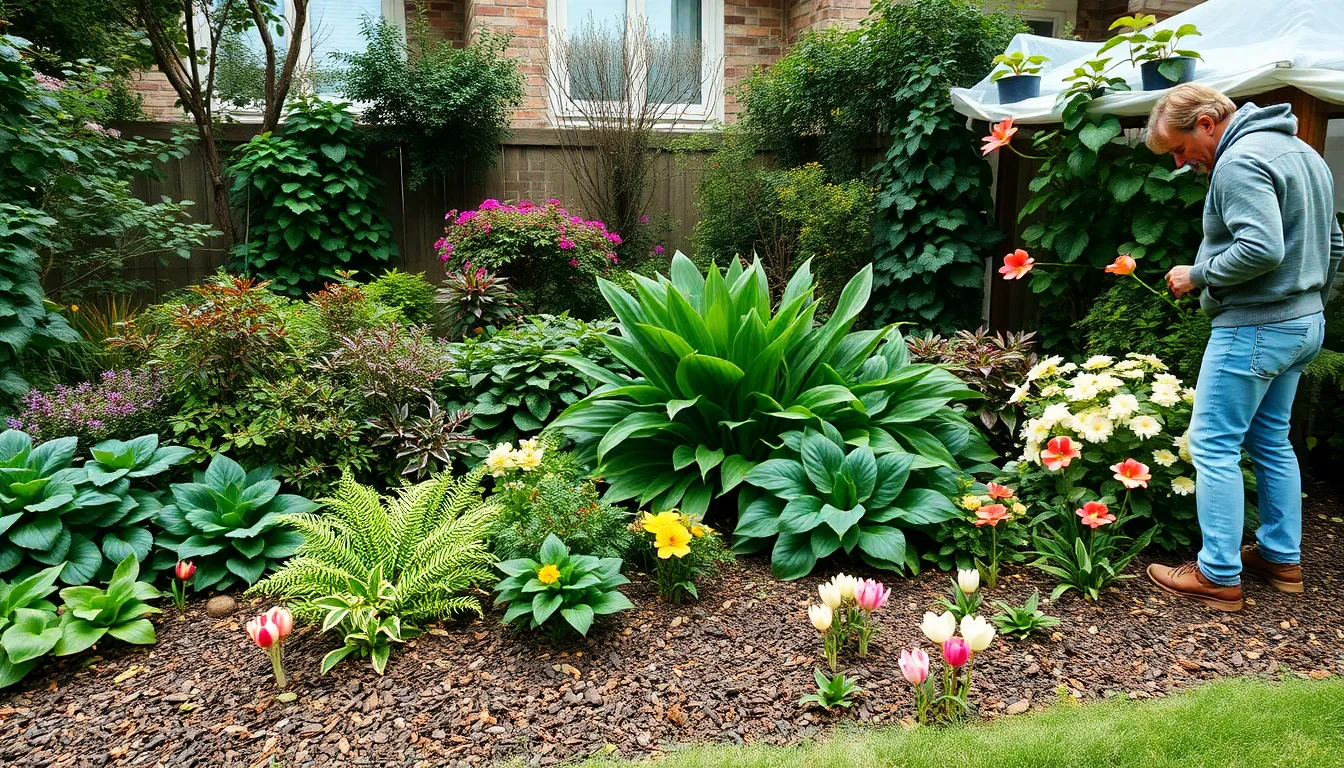
Successful north facing gardens require consistent attention throughout the changing seasons to maintain their lush appearance and plant health.
Seasonal Care Tasks for North Facing Gardens
Spring preparation sets the foundation for our garden’s success throughout the year. We’ll prepare soil with organic matter like compost and aged manure to improve drainage and nutrient content. Plant cool season vegetables including lettuce, spinach, and kale during this time since they thrive in the cooler conditions north facing gardens provide. Divide perennials like hostas and astilbe when new growth emerges to maintain plant vigor. Clean winter debris from pathways and garden beds to allow proper air circulation around our shade loving plants.
Summer maintenance focuses on moisture management and plant care in our shaded spaces. We’ll maintain consistent moisture levels through regular watering and mulch application since shade plants prefer evenly moist soil. Prune plants to maintain their shape and encourage healthy growth throughout the growing season. Deadhead spent flowers on impatiens, begonias, and other blooming plants to extend their flowering period. Monitor container plants more frequently as they dry out faster than ground plantings.
Fall preparation ensures our gardens transition smoothly into the dormant season. Clean up fallen leaves regularly to prevent fungal diseases that thrive in damp, shaded conditions. Plant spring bulbs like snowdrops, crocuses, and daffodils for early season color in our north facing beds. Apply a final layer of mulch around tender plants before temperatures drop. Cut back perennials after the first hard frost while leaving ornamental grasses standing for winter interest.
Winter care protects our investment in shade loving plants during harsh weather. Mulch around the base of plants with 3 to 4 inches of organic material to protect roots from freezing temperatures. Check and adjust plant covers or blankets as needed throughout the winter months. Avoid walking on frozen grass or soil to prevent damage to plant roots and soil structure.
Pest and Disease Prevention in Shade
Regular inspection helps us catch problems before they become serious issues in our north facing gardens. We’ll examine leaves weekly for signs of slugs, aphids, and scale insects that commonly affect shade plants. Look for yellowing leaves, black spots, or powdery substances that indicate fungal diseases thriving in humid, shaded conditions. Check the undersides of hosta and fern fronds where pests often hide during daylight hours.
Organic control methods provide effective answers without harming beneficial insects in our gardens. Use copper strips or diatomaceous earth around hostas and other slug prone plants to create natural barriers. Apply neem oil spray to affected plants every 7 to 10 days to control aphids and scale insects. Introduce beneficial insects like ladybugs and lacewings to maintain natural pest control in our shaded spaces.
Air circulation improvement prevents many common fungal diseases that plague shade gardens. Space plants appropriately according to their mature size to allow air movement between foliage. Remove lower branches from shrubs and trees to increase airflow at ground level. Install small fans in enclosed or heavily shaded areas where natural air movement is limited.
Winter Protection for Tender Plants
Covering strategies shield our most vulnerable plants from harsh winter conditions. We’ll use frost cloth or old blankets to cover tender perennials like caladiums and begonias when temperatures drop below 40°F. Wrap burlap around small trees and shrubs to protect them from ice damage and harsh winds. Create windbreaks using bamboo screens or evergreen boughs around exposed plantings.
Container plant protection requires special attention since roots are more exposed to freezing temperatures. Bring potted tender plants under cover or move them indoors to unheated garages or basements. Group containers together and surround them with mulch or leaves for insulation if indoor space is limited. Water containers thoroughly before the first hard freeze since dry soil freezes faster than moist soil.
Mulching techniques provide essential root protection throughout the winter months. Apply 4 to 6 inches of organic mulch around the base of tender plants after the ground begins to freeze. Use materials like shredded leaves, straw, or pine needles that won’t compact and smother plants. Pull mulch away from plant crowns in early spring to prevent rot as temperatures warm and growth resumes.
Conclusion
We’ve shown you that north-facing gardens aren’t limitations – they’re opportunities waiting to be discovered. With the right combination of shade-loving plants strategic lighting and thoughtful design elements your north-facing space can become the garden sanctuary you’ve always dreamed of.
The key lies in embracing what makes these gardens special rather than fighting against their natural characteristics. From lush hostas and delicate astilbe to productive leafy greens and cozy evening retreats we’ve covered everything you need to transform your shaded space.
Remember that successful north-facing gardens develop over time. Start small with a few foundational plants and gradually build your layers of texture color and seasonal interest. Your patience will be rewarded with a unique garden that thrives in conditions where others struggle.
Frequently Asked Questions
What plants thrive best in north-facing gardens?
Shade-loving plants like hostas, heuchera, ferns, and astilbe excel in north-facing gardens. Hostas provide dramatic foliage displays, while heuchera offers year-round color. Ferns add texture and movement, and astilbe brings delicate flowers. For seasonal color, consider caladiums and begonias in containers. These plants are low-maintenance and create stunning visual combinations in limited sunlight conditions.
How can I maximize light in my north-facing garden?
Use light-colored surfaces for pathways and patios to reflect available sunlight. Install mirrors and reflective elements to enhance brightness and create visual depth. Prune overhead branches to increase sunlight penetration, allowing dappled light patterns. Choose lighter-colored mulch and decorative materials. These strategies help brighten your garden atmosphere and support better plant growth.
Can I grow vegetables in a north-facing garden?
Yes! Many vegetables thrive in partial shade, including leafy greens like kale, spinach, and lettuce. Herbs such as mint, parsley, and chives also do well. Cool-season vegetables like broccoli, cauliflower, and Brussels sprouts benefit from shadier conditions. Consider shade-tolerant fruits like currants and gooseberries, plus edible flowers like nasturtiums and pansies.
How do I create year-round interest in a shaded garden?
Plan for seasonal variety with spring bulbs like snowdrops and crocuses, summer bloomers like impatiens and foxgloves, fall foliage from Japanese maples, and winter interest from evergreen shrubs and ornamental grasses. Include hellebores for winter blooms and plants with attractive bark. This strategic selection ensures your garden remains captivating throughout all seasons.
What hardscape features work best in north-facing gardens?
Light-colored stone pathways and patios maximize light reflection while creating functional spaces. Gravel paths add texture and improve drainage cost-effectively. Water features like small fountains introduce sound and movement. Garden sculptures serve as focal points, while mirrors amplify light and create the illusion of expanded space. These elements enhance both aesthetics and functionality.
Should I use raised beds or containers in my north-facing garden?
Both options offer excellent benefits for shaded gardens. Raised beds (8-12 inches high) improve drainage, soil quality, and accessibility while promoting better root growth. Containers provide flexibility to relocate plants for optimal light exposure and are perfect for seasonal displays. Vertical gardening techniques can maximize planting space and create multi-level visual interest.
How do I maintain proper soil conditions in a north-facing garden?
Use organic mulches like wood chips or bark for moisture retention and aesthetic appeal. Improve soil with compost, worm castings, and aged manure for better nutrient content. Enhance drainage with perlite or gravel while maintaining moisture levels. Consider French drains for areas with standing water issues. Regular soil amendments support healthy plant growth.
What lighting options work for evening garden enjoyment?
Solar pathway lights provide safety and illumination along garden paths. String lights create cozy ambiance for relaxation areas. Spotlights can highlight key garden features and plants. Combine with mirrors and reflective surfaces to amplify lighting effects. These options transform your north-facing garden into an inviting evening retreat extending usability beyond daylight hours.
